Best Way to Sow Carrots: No More Thinning or Weeding from Seed to Harvest
- June 4, 2024
- 0 comment
Carrots are a beloved addition to any garden, yet they can be tricky to grow due to their specific planting and care requirements. If you find yourself constantly thinning rows and fighting off weeds, I’m excited to share a revolutionary method that will transform your carrot-growing experience.
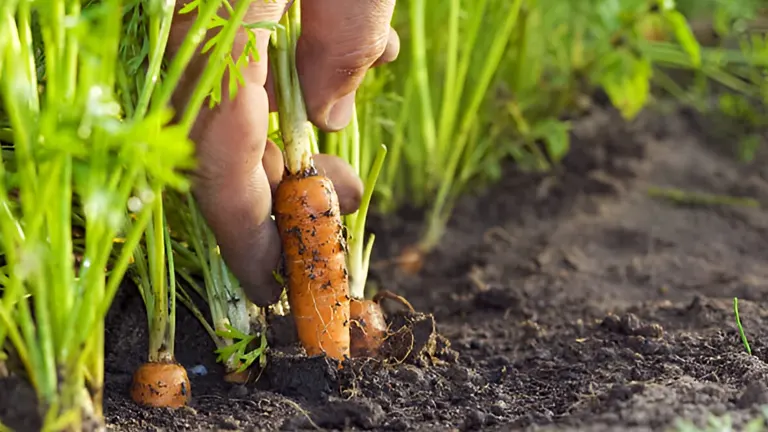
This step-by-step guide will show you how to prepare your carrot seeds and plant them effectively, aiming for optimal growth and a plentiful harvest, all while minimizing the usual gardening hassles. Get ready to revolutionize your approach and enjoy the fruits of your labor with less effort and more satisfaction.
Best Step-by-Step Method for Sowing Carrots
Step 1: Prepare the Carrot Seeds
Begin the process by setting up your carrot seeds for successful germination. Select a small container and line the bottom with two layers of toilet paper. This foundation will help maintain the necessary moisture balance. Over the toilet paper, place a cloth that will hold the seeds and allow for even moisture distribution. Spread your carrot seeds evenly across the cloth to ensure they have ample space to grow without crowding. Once the seeds are in place, cover the container with stretch film.

Poke several holes in the film to allow excess moisture to escape, preventing over-saturation which could hinder the germination process. Place the container in a warm, dark location — an environment that encourages faster germination. Keep an eye on the progress, and by the fourth day, you should see sprouts appearing. These sprouts indicate that your seeds are ready to move on to the next stage of planting. This preparatory step is essential for setting the stage for healthy growth and robust carrot plants.
Step 2: Prepare Planting Trays
To set up your planting trays effectively, utilize trays from under eggs as the foundation for growing your carrots. Begin by modifying these trays to accommodate the deep root growth necessary for healthy carrot development. Using regular scissors, carefully pierce and gently twist to make holes in each compartment of the egg tray. Ensure that you do not cut out the bottoms entirely; the goal is to create openings just large enough for roots to grow through without hindrance.
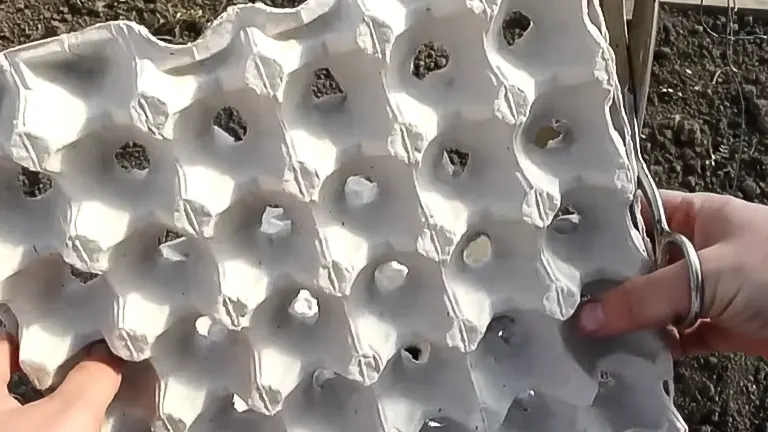
The advantages of using egg trays for planting carrots are significant. These trays promote even spacing between each plant, which is crucial for uniform growth. They also enhance moisture retention within each cell, ensuring that the soil remains moist but not waterlogged, which is ideal for carrot growth. Additionally, this method eliminates the need for the laborious task of thinning young plants, as each pre-sprouted seed is allocated its own individual space, allowing for optimal development right from the start.
Step 3: Soil Preparation
To prepare the soil for planting your carrot seeds, create a mixture by combining store-bought soil with sand and coconut substrate in equal parts. This blend not only increases the volume of your planting medium, making it more cost-effective, but also enhances its quality.

The coconut substrate is particularly beneficial as it loosens the soil and improves moisture retention—two qualities that are highly favorable for carrot growth. After mixing, fill each cell of your egg trays with this soil mixture, pressing it down firmly to eliminate air pockets. Ensure the depth of the soil in each cell allows you to plant the carrot seeds shallowly, no deeper than 1 cm. This shallow planting is vital for quick sprouting and robust early growth of the carrots.
Step 4: Sowing the Seeds
For effective planting of your carrot seeds, carefully use tweezers or a toothpick to place each sprouted seed into the holes you’ve prepared in your egg trays. Ensure that the root end of each seed points downward.
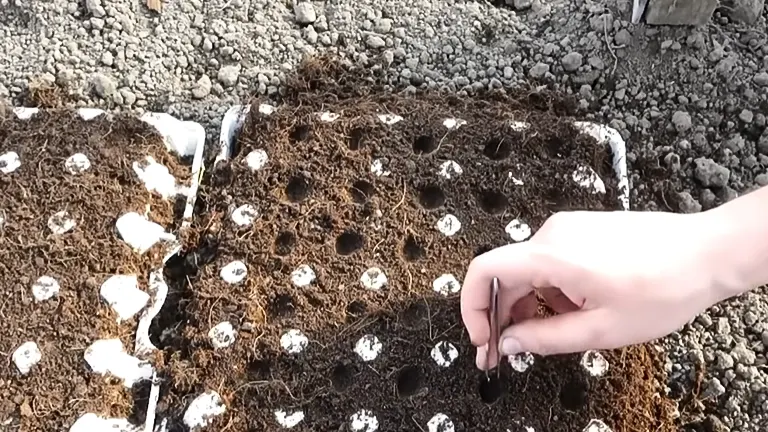
This precise placement prevents the seeds from being buried too deep, a common issue that can inhibit germination and lead to weaker plants. By maintaining control over the depth at which the seeds are planted, you promote faster and more robust growth, setting the stage for a healthy carrot crop.
Step 5: Finalizing the Plant Bed
After positioning your seeds in the egg trays, gently sprinkle a thin layer of soil over them, making sure not to cover them more than 1 cm deep. This ensures the seeds have just enough coverage to protect them without hindering their growth. Next, water the seeds carefully, targeting the water directly on the soil above each seed to moisten it without oversaturating the entire tray.
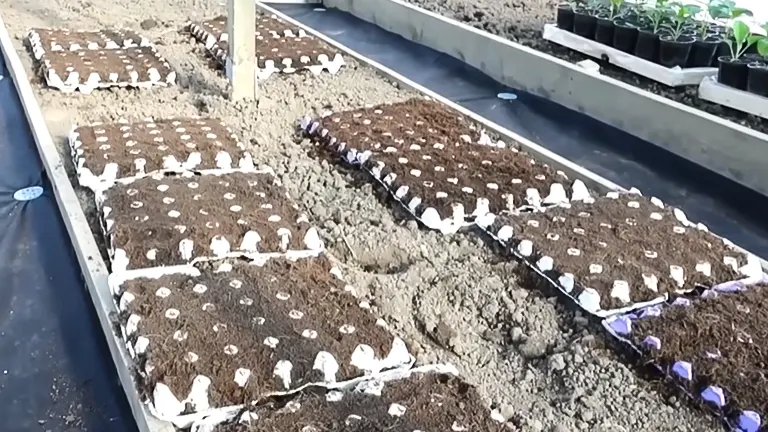
Select a well-lit area in your garden that can accommodate the size of the egg trays. Prepare this spot by creating a shallow depression, about 5 cm deep, to set the trays in. This placement helps the trays sit level with the ground surface, which is essential for preventing waterlogging and ensuring optimal growing conditions for your carrots.
Step 6: Transplantation and Maintenance
Once your carrot seeds have sprouted and are ready for the garden, carefully transfer the egg trays using a shovel. This helps avoid disturbing the young plants. Position the trays in your garden bed, ensuring there’s a small gap between each tray. These gaps are essential as they allow you to later fill them with soil, which supports the trays as the cardboard begins to decompose and prevents the soil from sinking down, which could affect root growth.

After positioning the trays, give the area a thorough watering to settle the soil and provide moisture for the carrots. It’s also beneficial to add either organic or mineral fertilizers at this stage. These nutrients will support your carrots as they grow, promoting strong, healthy development throughout the season. Regular maintenance, including watering and occasional feeding, will help ensure a robust crop of carrots.
Results: Healthy, Robust Carrots
With this innovative egg tray planting method, you can expect to see large, healthy carrot sprouts much earlier compared to traditional sowing methods. This approach not only accelerates the growing process but also yields significantly larger carrots.
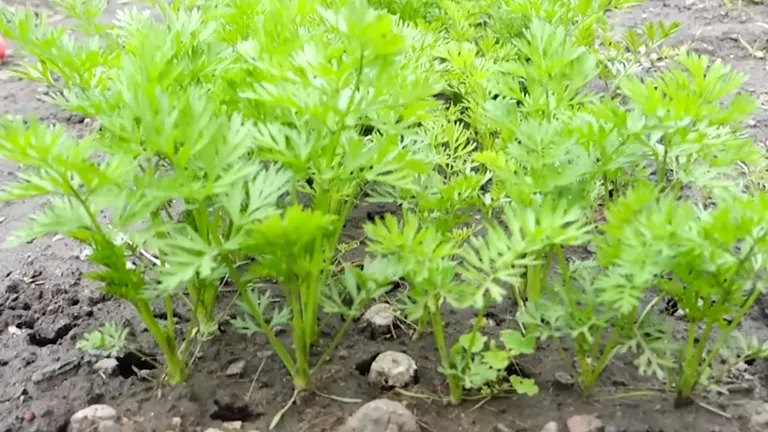
The strategic use of cardboard in this method effectively blocks weeds, dramatically reducing maintenance efforts. This clever technique ensures that your carrots grow vigorously and evenly, providing you with a bountiful and hassle-free harvest.
Tips for Success: Enhancing Your Carrot Growing Experience
To help you achieve the best results with the egg tray method of planting carrots, here are some additional tips to ensure success:
- Best Planting Time: Carrots can be planted in the early spring or late summer. For spring planting, sow seeds a couple of weeks before the last expected frost. For a fall harvest, plant about 10-12 weeks before the first expected frost. Carrots appreciate cooler weather and the soil temperatures should ideally be between 55-75°F for optimal germination.
- Dealing with Pests: To protect your carrot crops from common pests like carrot flies, use floating row covers right after planting. Keep the soil well-weeded and avoid thinning the carrots too late in the day, as this can attract pests. Companion planting with onions or leeks can also help deter carrot flies.
- Watering Practices: Water your carrots regularly to keep the soil moist but not soggy. Consistent moisture is important, especially as the carrots begin to form. Avoid over-watering as this can lead to split carrots.
- Thinning: Although thinning is reduced with the egg tray method, you may still need to check and gently remove any overcrowded sprouts. This ensures that each carrot has enough space to grow properly.
- Harvesting Without Disturbance: To harvest your carrots without disturbing the others, gently loosen the soil around the carrot you want to pull out using a garden fork. This method helps prevent damage to the roots of neighboring plants. Harvest carrots early in the morning when the soil is cooler and the roots are firm.
- Soil Health: Enrich the soil with well-rotted compost before planting to provide essential nutrients. Carrots prefer sandy loam soil that is loose and free of stones, which allows for better root development.
- Regular Check-Ups: Regularly check your carrot plants for signs of stress, pest infestation, or nutrient deficiencies. Yellowing leaves or stunted growth can indicate a need for more attention, such as adjusting the soil nutrients or water intake.
Comparison With Traditional Carrot Planting Methods
Adopting the egg tray method for planting carrots offers several distinct advantages over traditional carrot gardening techniques. Here’s a detailed comparison to highlight the benefits and differences:
- Effort and Time Investment:
- Traditional Method: Typically involves sowing seeds directly into the garden soil, requiring extensive preparation to ensure the soil is finely tilled and free of stones or debris. After sowing, carrots need frequent thinning to prevent overcrowding, which is labor-intensive and time-consuming.
- Egg Tray Method: Simplifies the initial planting process by using pre-prepared trays, reducing the need for soil tilling and eliminating the thinning process altogether. This method significantly cuts down on the time and physical effort required during the early stages of carrot growth.
- Cost-Effectiveness:
- Traditional Method: This may require multiple seed purchases if initial sowing doesn’t achieve the desired density due to uneven germination rates. The cost of weed control and extra fertilizers for larger open areas can also add up.
- Egg Tray Method: A more controlled environment means almost every seed germinates, reducing waste and the need for buying additional seeds. The compact nature of the trays also minimizes the use of soil and fertilizer per plant.
- Yield Differences:
- Traditional Method: Can be unpredictable. While direct soil contact provides natural growth conditions, it also exposes seeds to uneven distribution, competition from weeds, and potential pest issues, all of which can affect yield.
- Egg Tray Method: By controlling the germination environment and spacing, this method promotes more uniform growth and can potentially increase yield per square foot. The reduced competition from weeds and pests allows more nutrients and space for each carrot, leading to potentially larger and healthier output.
- Weed and Pest Management:
- Traditional Method: Weeds are a constant challenge and require regular manual removal or the use of herbicides. Carrots are also more exposed to soil-borne pests and diseases.
- Egg Tray Method: The design inherently blocks most weeds from growing near the carrots and reduces direct soil contact, which can lessen pest invasions. This not only saves effort in weeding but also reduces the risk of pest damage.
- Soil Quality and Preparation:
- Traditional Method: Requires meticulous soil preparation. The soil must be loose and deep enough to accommodate the growth of carrot roots, which involves significant digging and possibly the removal of stones or hard clumps.
- Egg Tray Method: As the primary soil contact is within the controlled environment of the tray, there’s less dependency on the overall quality of the garden soil. This is particularly advantageous for gardeners dealing with poor soil conditions.
Conclusion
Planting carrots in egg cartons is an efficient, innovative method that yields evenly spaced, large carrots without the hassle of thinning or weeding. Try this approach for your next carrot planting session and enjoy the simplicity and effectiveness it brings to your gardening efforts.
FAQs
- What is the best type of soil to use for planting carrots in egg trays?
Carrots thrive in loose, well-draining soil. For the egg tray method, a light mix of garden soil combined with sand and some organic matter such as compost works best. This mixture helps ensure proper drainage and provides the nutrients carrots need to grow healthily. - Are there alternatives to coconut substrate?
Yes, if coconut substrate is not available, you can use peat moss or perlite as an alternative. Both materials help to loosen the soil mixture, improving aeration and moisture retention. Make sure whatever substitute you use is free of chemicals and suitable for organic gardening if that’s a concern. - What should I do if sprouts don’t appear as expected?
First, ensure that the seeds are not planted too deep; they should be no more than 1 cm below the surface. Check if the soil temperature and moisture levels are optimal—carrots germinate best at temperatures between 55-75°F. If conditions seem right but sprouts still don’t appear, it might be necessary to check the viability of the seeds or consider starting with a fresh batch. - How often should I water my carrot plants in egg trays?
Watering needs may vary based on the climate and indoor environment, but generally, carrot seeds in egg trays should be kept consistently moist but not waterlogged. Water gently to prevent washing away the seeds, and as the plants grow, reduce the frequency to encourage deeper root development. - Can I use egg trays made from materials other than cardboard?
Yes, while cardboard is biodegradable and adds to the soil’s nutrient content as it decomposes, you can also use plastic egg trays. However, you will need to ensure good drainage, so make additional holes if necessary. Plastic trays are durable and reusable but won’t provide the same moisture retention or environmental benefits as cardboard. - How do I protect my carrot sprouts from pests?
Keeping the area clean and free from debris can help minimize pest issues. If pests become a problem, consider using floating row covers to protect the sprouts without the need for chemical treatments. Always opt for organic pest control methods, especially with edible plants like carrots.
I hope you found this guide on planting carrots using egg trays helpful and inspiring! If you try this method, or if you have any questions, tips, or experiences to share, please leave a comment below. I love hearing from fellow gardeners and learning from your insights. Don’t forget to share this article with your friends and family who might also enjoy a simpler, more efficient way to grow carrots. Happy gardening!

David Murray
Forestry AuthorI'm David Murry, a forestry equipment specialist with a focus on chainsaw operation. With over 13 years of experience, I've honed my skills in operating and maintaining a wide range of machinery, from chainsaws to log splitters. My passion for the outdoors and commitment to sustainable forestry drive my work, which emphasizes safety, efficiency, and staying updated with industry advancements. Additionally, I'm dedicated to sharing my expertise and promoting environmental awareness within the forestry community.




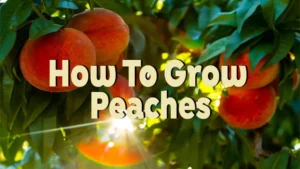



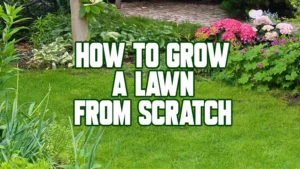




Leave your comment